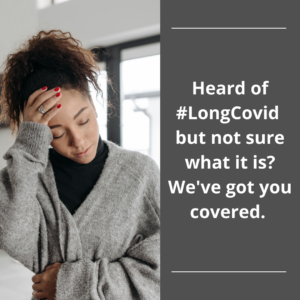 You may have heard about people who got a COVID-19 infection and have symptoms for weeks or months after. This is now referred to as Long COVID. In this post we’re going to dive into what Long COVID is, what the symptoms are and who it affects. Next month we’ll talk about strategies that are helping people with Long COVID and where physical therapy fits in. Let’s get started.
You may have heard about people who got a COVID-19 infection and have symptoms for weeks or months after. This is now referred to as Long COVID. In this post we’re going to dive into what Long COVID is, what the symptoms are and who it affects. Next month we’ll talk about strategies that are helping people with Long COVID and where physical therapy fits in. Let’s get started.
What is Long COVID?
Long COVID is generally defined as ongoing signs or symptoms lasting 12 weeks or more after a COVID-19 infection.
What is it like?
Like all things COVID-19, we don’t fully understand Long COVID and new information is being discovered all the time. Long COVID tends to involve more than one system and currently has a list of over 200 possible symptoms. The most common are:
- Fatigue
- Post-exertional symptom exacerbation (PESE)
- Problems with memory or concentration, often referred to as “brain fog”
Other common symptoms are shortness or breath, chest pain or tightness, insomnia, muscle or joint pain, depression/anxiety, and stomach problems like stomach aches, loss of appetite or diarrhea.
What’s the fatigue like? Does rest help?
Long COVID fatigue is an extreme exhaustion that isn’t relieved by rest or sleep. It’s not fatigue after some physically demanding task. People experience exhaustion for no obvious reason. The fatigue is so severe that it impacts the ability to complete daily tasks.
What about this PESE thing?
Post-exertional symptom exacerbation is a disabling and often delayed exhaustion disproportionate to the effort made. Patients are referring to this as a “crash”. PESE is very common in people suffering from Long COVID. 75% of people who have Long COVID have PESE after 6 months. The activity that brings on the crash is something that the person could easily tolerate before their COVID-19 infection. Things like taking a shower, walking, attending a social activity, or even being in a high sensory environment with flashing lights and loud noises may all now trigger a crash.
Who does Long COVID affect?
This is difficult to answer. We still don’t understand what causes some people to have symptoms long after their initial infection. What we do know is that about 25% of people who get COVID have symptoms that last at least a month. Around 10% of the people who get the virus will experience Long COVID. Long COVID isn’t related to how severe your initial symptoms were, or if you were hospitalized. It also doesn’t appear to be related to your previous health as it affects children and people who were previously fit and healthy.
Now that you know what Long COVID is, in our next installment we’ll talk about what’s being done for it and how physical therapy helps. 
